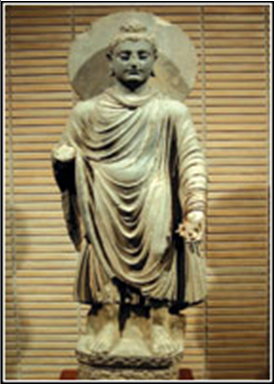Gandhara, Buddhist
This is a collection of articles archived for the excellence of their content. Readers will be able to edit existing articles and post new articles directly |
Gandhara, Buddhist
Seeking Buddha In Gandhara
By Intizar Husain
THE book I have just read takes us back to the distant past of our land. And yet I feel that it is most relevant to our times. The region it deals with now stands precariously at a crossroads. Will it be able to protect its cultural heritage coming down to it from centuries, or is it fated to undergo a Talibanised transformation.
The book is a Sang-i-Meel publication titled Buddhist Gandhara. It is a work by Ihsan H. Nadeem, who has already to his credit such works as Built Heritage of Pakistan, Historic Mosques of Lahore, Makli, the Necropolis of Thattas, Moenjodaro and Thar: the great Pakistani desert. Associated with Pakistan’s Department of Archaeology, he has excavated Bhanbhore, Swat, Moenjodaro and Tulamba.
Ihsan Nadeem’s work has won international recognition, bringing laurels for him. In Sri Lanka, in particular, the work was received with much enthusiasm. Having been translated into the Sinhalese language, a wider range of Sri Lankan readers have access to it. It also helped to explain Gandhara’s geographical situation in South Asia and that away from India it forms part of Pakistan. In his Preface the author has explained that he has ‘tried to put together the information, exclusively dealing with this region, about Buddhism, Buddhist art and architecture and history of the area in a precise form which would be easily understood by a layman and a scholar alike.’
Gandhara originally is said to be the name of the king, who ruled for some time over this region. As told by the author, the first mention of Gandhara in historical literature is found as its being part of the Achaemenion Empire in the times of Cyrus the Great (558-528 BCE). Alexander the Great conquered it in 327-326 BCE. Herodotus mentions it as being a melting pot of Persian and South Asian Vedic traditions with Taxile or Takshashila as its capital. The period of Greek rule was brief. But the socio-cultural pattern of the Greeks somehow succeeded in penetrating to a large extent into the social life of this region.
The Greeks were followed by the Mauryans, who ruled it while their capital was in the distant city of Patliputr, now known as Patna. From among them arose Ashoka the Great during the 3rd century BCE. His conversion to Buddhism marks the Buddhist period of Gandahara. The next great king who ruled this region rose from among the Kushans, a race of Chinese origin,who had conquered it around the middle of the first century BCE. His name was Kanishka. He too converted to Buddhism.
Numerous monasteries and stupas were built all over the empire which were meant to contain the relics of Buddha and Buddhist saints. It was during this period that the Gandharan art developed. ‘Blending Hellenistic and Indian influences, the style depicted Buddha in human form for the first time, often with features resembling the Greek god Apollo and a Persian solar disk or a around the head halo.’
In the context of the Buddhist history of Gandhara, Kanishka may be seen as the successor of Ashoka. It was during his rule and because of his zeal for Buddhism that numerous monasteries and stupas were built all over the empire. They were meant to contain the relics of Buddha and Buddhist saints. And Ihsan Nadeem tells us that it was during this period that the Gandharan art developed. ‘Blending Hellenistic and Indian influences, the style depicted Buddha in human form for the first time, often with features resembling the Greek god Apollo and a Persian solar disk or a around the head halo.’
Gandhara reached its zenith during the reign of the Kushans. It was now a prosperous country with Buddhism as the spiritual force behind it. It was this force which gave a fillip to the arts, particularly sculpture and architecture which found their best expression in Buddhist pieces of art.
But all this came to naught at the hands of the White Huns. The prosperous and culturally advanced Gandhara could not withstand the onslaughts of the barbarian hordes. This cradle of culture and arts faced great devastation at the hands of these invaders, who burnt monasteries and massacred people to their hearts’ content. It all happened in about 460 CE.
Such is the history of Gandhara as traced here. We are also introduced to what is known as Gandhara art and architecture and to Buddhism which flourished in this region and gave birth to a great artistic tradition.
The author is of opinion that in the beginning Buddha was treated as an inspired teacher. It was at a later stage that he was taken as a divine being and Buddhism took the shape of a religion. Of the two schools, Hinayana and Mahayana, the latter in particular promoted the belief that Buddha was a divine being. And it was this school of thought which flourished in Gandhara. The artistic expression patronised by this school gave birth to the artistic tradition which came to be known as Gandhara art. So we have here a detailed account of Buddha along with a procession of Bodhisattvas as sculptured in different contexts. This account is followed by an equally detailed description of stupas and monasteries built here which were meant to enshrine the relics of Buddha.
Along with the account in words the book contains a large number of pictures and facsimiles of sculptured Buddhas and Bodhisattvas, and of stupas and monasteries. This has added to the value of this volume which may well be considered as a deluxe publication.

